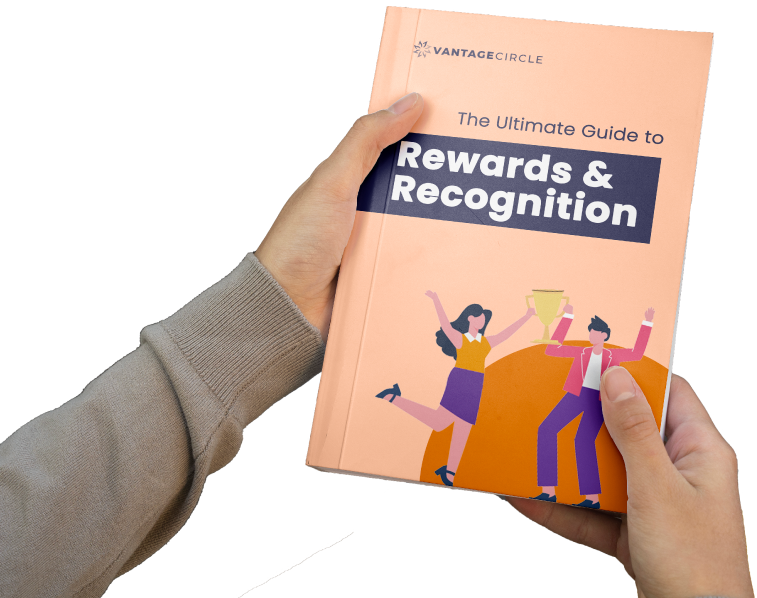The Complete Guide to Employee Recognition in 2025: Using the AIRe Framework

A Global Employee Recognition and Wellness Platform
Let’s be honest — in 2025, employee recognition can make or break your workplace.
Do it right, and you inspire loyalty, motivation, and performance.
Do it wrong, and you watch your best people walk out the door.
The cost of getting it wrong?
Disengaged employees. Sky-high turnover. Lost productivity.
Gallup estimates the disengagement costs the world economy a whopping 438 billion in 2024. One prime reason? Lack of recognition in the workplace.
So, what’s changed in 2025?
-
Remote and hybrid teams mean fewer “spontaneous thank-you” moments.
-
Employees expect recognition that’s personal, frequent, and genuine.
-
A strong culture and emotional connection matter just as much as salary.
This is where the AIRe Framework comes in.
Built around four pillars — Appreciation, Incentivization, Reinforcement, and eMotional Connect — AIRe bridges the gap between human connection and data-driven impact.
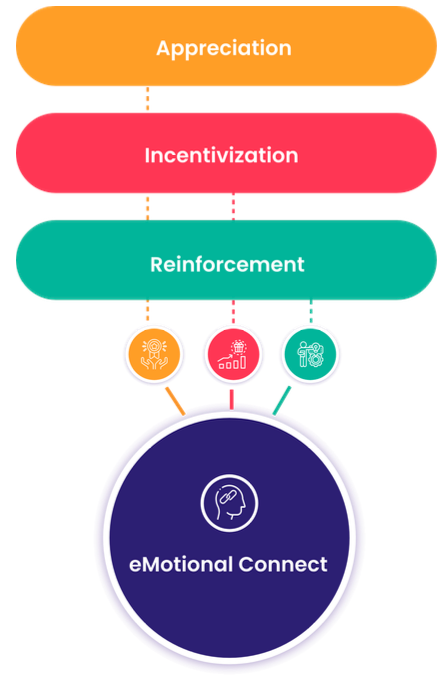
We will discuss more about the AIRe framework later in the blog.
In the meantime ask this question: Is recognition about generic rewards?
If your answer is yes then you need to re-evaluate your approach towards recognition.
However, my answer will always be no, it’s not. It’s about creating a recognition system so intentional and impactful that it becomes your competitive edge.
Because in today’s workplace, recognition isn’t an HR checkbox.
It’s a culture multiplier — and AIRe is the blueprint.
Key Takeaways
- What is recognition and why it matters.
- How to Build the Best Recognition Program (Step by Step Approach).
- How to Choose the Right Digital Recognition Platform.
- The Best High-Impact Employee Recognition Ideas That Actually Work.
- How to Measure the Success of Employee Recognition.
- Your 90-Day Employee Recognition Implementation Roadmap.
What is Employee Recognition?

Employee recognition is the intentional act of acknowledging and appreciating employees for their contributions, achievements, and positive behaviors at work.
It can be as simple as a verbal “thank you” or as structured as a formal rewards program — the goal is always the same: to make people feel valued and seen for the work they do.
Why is Employee Recognition Important for Business
After years in the recognition sector, I've learned one hard truth: employee recognition isn't touchy-feely HR nonsense. It's business survival.
The companies that get this right dominate their industries. The ones that don't? They're constantly bleeding talent, wondering why their best people keep walking out the door.
Recognition drives everything— retention, performance, culture, and ultimately, your bottom line. Here's why smart leaders are making it a strategic priority.
1. Boosts Employee Retention

The research is brutal but honest: companies with recognition programs lose 31% fewer employees.
But let me tell you what that really means in human terms.
Last year, I watched a competitor lose their entire marketing team in four months. Not because of pay—they were paying well. Not because of workload—it was reasonable. They lost them because nobody said "thank you" for the campaign that saved Q3.
Meanwhile, our marketing director still talks about the handwritten note our CEO left on her desk after that same type of win three years ago. She's had five job offers since then. She's turned down every single one.
That's the thing about recognition—it creates an invisible tether. When people feel seen, really seen, they don't just stay for the benefits. They stay because leaving would feel like abandoning family.
2. Lifts Engagement and Productivity

A survey found that 69% of employees reported they would increase their effort if they felt more appreciated for their work. Sounds impossible? I used to think so too.
Then I met Marcus.
Average sales rep. Nice guy, decent numbers, nothing special. His manager started a simple ritual—every Friday, she'd highlight one creative thing Marcus did that week in the team meeting. It could be how he handled a difficult client or a clever follow-up email.
Six months later, Marcus was employee of the year. Not because he suddenly got talented overnight, but because someone finally noticed the talent that was always there.
Here's what blew my mind: when Marcus felt valued, he started valuing his work differently. He stopped phoning it in. He started innovating, taking risks, helping teammates. Recognition didn't just change his output—it changed his identity.
3. Strengthens Company Culture

Culture isn't what you put on posters. Culture is what you celebrate.
I learned this the hard way during a company merger. We had beautiful values statements about "innovation" and "collaboration." But we only recognized individual achievements and safe, predictable wins.
Guess what happened? People stopped sharing ideas. They stopped taking risks. Innovation died, even though it was literally written on the wall.
The turnaround started when we began spotlighting the "beautiful failures"—the bold ideas that didn't work but taught us something valuable. Within months, our team meetings transformed from status reports to idea labs.
Recognition doesn't just reflect your values. It shapes them, one story at a time.
Recommended Resource: 10 Ways to Create a Great Company Culture
4. Drives Financial ROI

Companies focusing on recognition see higher revenue per employee and stronger financial performance.
I remember my first presentation to a skeptical CFO. "Show me the ROI on saying 'good job,'" he said.
Six months later, after implementing our recognition program, he was a convert. Our customer satisfaction scores jumped. Employee referrals tripled. Sick days dropped by a significant number.
But the moment that sealed it? A customer email praising our support team's attitude. "They seem to genuinely care," she wrote. That caring attitude? It started with us caring about them first.
Happy employees don't just work harder—they work with heart. And customers can feel the difference. A Harvard study states that: In businesses with highly engaged teams, profitability increased by 21%, sales productivity by 20%, and output quality by 40%.
The AIRe Framework: Your Strategic Recognition Blueprint
Think of the AIRe Framework as your GPS for building recognition that actually works. No more generic "employee of the month" nonsense that makes everyone cringe. No more throwing money at programs that leave people feeling more disconnected than before.
Read more on strategic recognition and how leadership plays a key role with our blog on, Strategic Recognition- How Leaders Can Drive Business Outcomes Through Recognition
AIRe stands for Appreciation, Incentivization, Reinforcement, and eMotional Connect—four pillars that separate recognition programs that transform culture from those that waste everyone's time.
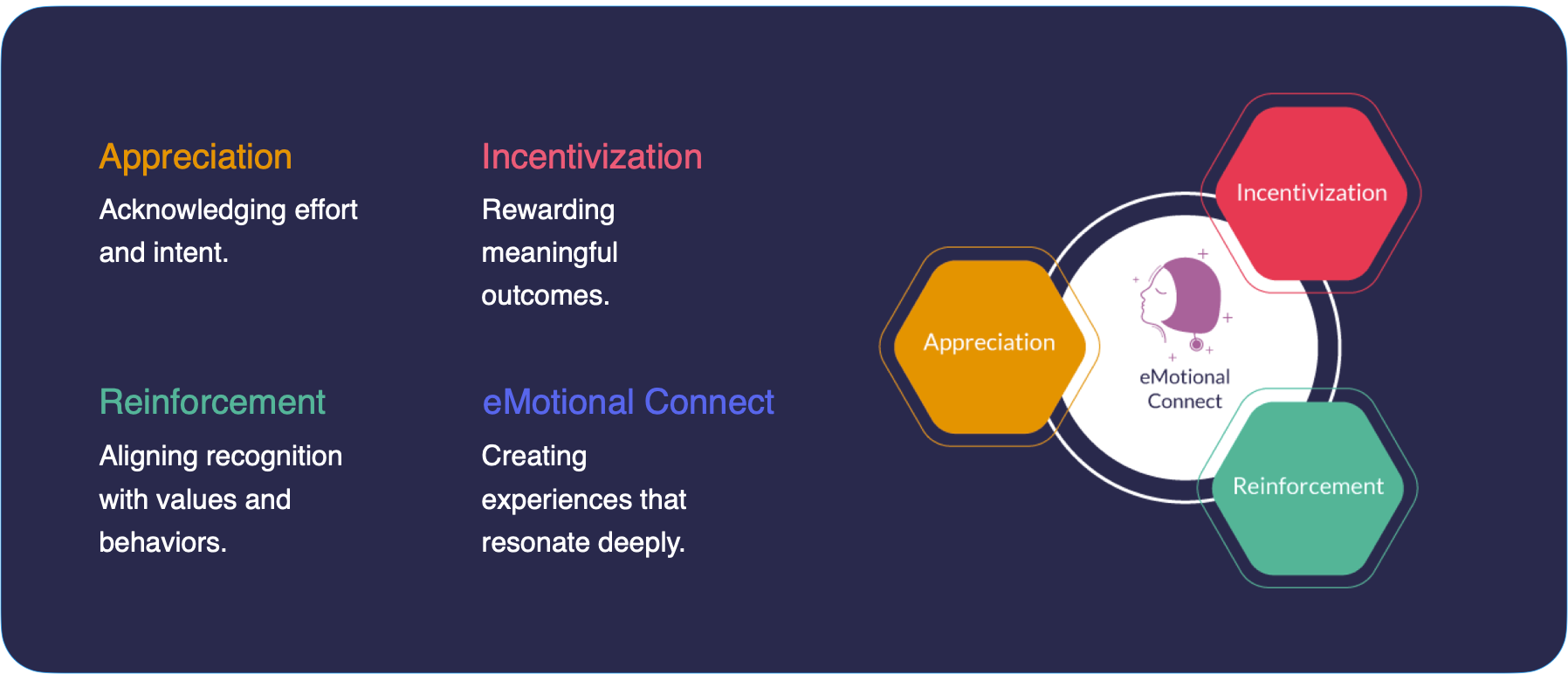
Most companies treat recognition like checking a box. They implement something, hope it works, then wonder why their engagement scores still suck. AIRe flips that thinking. It's strategic, deeply human, and designed to actually change how people feel about showing up to work.
To know more about our AIRe framework you can click here.
A - Appreciation: Acknowledge Inherent Value

The Psychology of Appreciation
Here's what most leaders miss: appreciation isn't about what someone accomplished—it's about who they are.
When you say, "Great job hitting your quota," you're recognizing performance. When you say "I really value how you always support struggling teammates," you're appreciating character. One celebrates what someone did. The other celebrates who someone is.
Appreciation vs. Recognition vs. Rewards
Let me break this down simply:
-
Appreciation = acknowledging someone's inherent worth
-
Recognition = celebrating specific achievements
-
Rewards = tangible benefits for performance
Smart companies use all three, but appreciation is your foundation. Without it, the other two feel fake and transactional.
Building Appreciation into Daily Operations
Forget the grand gestures. Micro-moments matter more.
I train managers to look for character moments, not just performance wins. Build it into your rhythm—one-on-ones, team meetings, casual conversations. Make it systematic, not sporadic, or it won't stick.
Appreciation Measurement Strategies
Track it like you would any other business metric. Pulse surveys, manager coaching sessions, psychological safety scores. If people don't report feeling valued for who they are (not just what they produce), your appreciation efforts aren't working.
I - Incentivization: Inspire Aspiration

Motivational Theory in Practice
Here's what took me years to learn: people aren't motivated by what you want to give them. They're motivated by what they actually want.
Daniel Pink's research in "Drive" confirmed what I was seeing in the field—autonomy, mastery, and purpose consistently beat money as motivators. Design incentives that feed these deeper hungers, and you'll see performance you didn't think was possible.
Designing Desirable Incentives
Stop guessing what motivates people. Ask them.
I run annual "motivation audits" because what excites your team might surprise you. The new parent wants flexible schedules over bonuses. The ambitious junior employee craves mentorship with executives over gift cards.
Non-Monetary Incentive Strategies
Some of my most successful incentives cost almost nothing: learning sabbaticals, lunch with the CEO, first pick on interesting projects. These create lasting value that outlives any cash bonus.
Incentive Personalization
One-size-fits-all incentives are one-size-fits-nobody.
Build a menu. Let people choose what lights them up. The conference for one person, extra PTO for another. When people feel you've paid attention to what makes them tick, everything changes.
R - Reinforcement: Guide Desired Behaviors

Behavioral Psychology Applications
You can't manage results—you can only manage the behaviors that create results.
Catch people doing things right and reinforce immediately. Wait too long, and the moment loses its power. This isn't rocket science, but most companies still screw it up.
Linking Recognition to Company Values
Company values without recognition are expensive wall decorations.
Create specific examples of what each value looks like in action, then recognize those behaviors when you see them. This turns abstract corporate speak into lived experiences that actually shape culture.
Performance Behavior Mapping
Don't just celebrate the touchdown—celebrate the plays that led to it.
If collaboration drives innovation, recognize collaborative behaviors before they produce breakthrough results. You're programming future success, not just marking past achievements.
Continuous Reinforcement Loops
The best recognition creates momentum. High performers get stretch assignments, which create new recognition opportunities, which drive continued growth. It's a beautiful cycle when it works.
e - eMotional Connect: Foster Human Bonds

Building Emotional Intelligence
Recognition without relationship is just transaction.
I've watched identical recognition programs get completely different results based on one thing: whether managers actually understood their people. Train your leaders in emotional intelligence, or all the frameworks in the world won't save you.
Peer-to-Peer Connection Strategies
The most powerful recognition comes sideways, not down from above.
When your colleague says "you saved that project," it hits different than when your boss says it. Create structured ways for teammates to recognize each other. It feels more authentic and builds the team bonds that prevent turnover.
Manager-Employee Relationship Building
Strong relationships make recognition meaningful instead of mechanical.
Invest in manager training that goes beyond performance reviews. Teach them to have real conversations about fears, aspirations, and growth. Without that foundation, recognition feels hollow.
Cross-Team Collaboration Enhancement
Recognition can break down silos better than any org chart restructure.
When departments collaborate successfully, celebrate both teams together publicly. You're sending a clear message: we win together, we get recognized together.
AIRe Framework Assessment Tool
Measuring Your Current State
Be brutally honest about where you stand. Score each dimension: How well do you appreciate inherent value? Are incentives actually motivating? Does recognition reinforce the right behaviors? Do people feel emotionally connected?
Most companies are strong in one area and terrible in others. That's your starting point.
Gap Analysis Methodology
Look for patterns in your gaps. Maybe you're great at incentivization but weak on emotional connection. Or strong on appreciation but inconsistent on reinforcement. Focus your efforts where they'll make the biggest difference.
Improvement Priority Matrix
Start with high-impact, low-effort wins. Manager appreciation training might transform your culture without breaking your budget. Build momentum, then tackle the bigger challenges.
The bottom line: AIRe isn't just another framework—it's the difference between recognition that changes lives and recognition that wastes everyone's time. When you get all four pieces working together, people don't just work for you—they choose to build their futures with you.
Assess your AIRe score here.
How to Build the Best Recognition Program (Step by Step Approach)
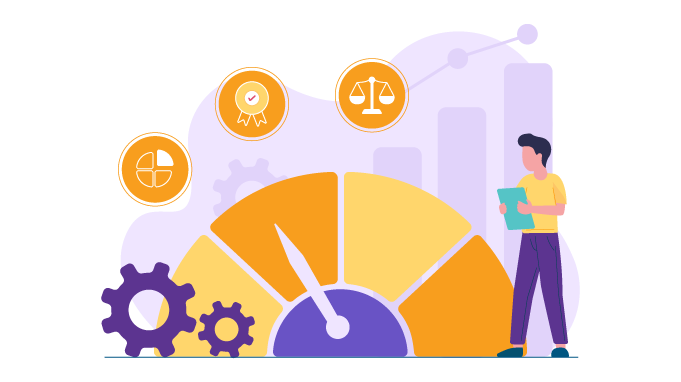
Too many companies dive headfirst into recognition programs without thinking it through. They pick flashy rewards, launch with fanfare, then wonder why engagement scores barely budge six months later.
Building a recognition program isn't rocket science, but it's not plug-and-play either. It's like building a house—you need a solid foundation before you worry about the pretty fixtures.
Here's your step-by-step blueprint for creating recognition that actually moves the needle on engagement, retention, and performance.
Step 1: Define Clear, Measurable Objectives

SMART Goal Setting for Recognition
I still cringe when executives tell me they want to "make people happier" with recognition. That's not a goal—that's a wish.
Your recognition program needs teeth. Set specific targets like "increase engagement scores by 15% in six months" or "reduce turnover in our top performers by 20%."
Why? Because vague goals lead to vague results. And vague results get budgets cut faster than you can say "employee appreciation."
Learn more: SMART Goals For HR professionals- A Quick Review With Examples
Business Outcome Alignment
Here's what separates programs that last from expensive thank-you note systems: recognition must drive behaviors that actually matter to your business.
If innovation keeps you competitive, recognize creative problem-solving and smart risks. If customer service is your edge, celebrate those amazing client saves. I've seen too many programs recognize "being nice" while ignoring the behaviors that drive revenue.
Success Metric Definition
Pick 3-5 metrics and track them obsessively. I focus on engagement scores, turnover rates, performance indicators, and culture survey results.
More than five metrics? You'll drown in data. Fewer than three? You'll miss the story your program is telling you.
Step 2: Establish Recognition Criteria & Guidelines

Values-Based Criteria Development
Company values without specific examples are just expensive wall art.
I learned this the hard way when an employee told me, "I don't know what 'collaboration' means here. Does helping with a deadline count? What about sharing my expertise?"
Now I create behavioral examples for every value. "Collaboration" becomes "Mark helped marketing meet their deadline by sharing her design skills." People remember stories, not abstract concepts.
Behavior-Specific Recognition
"Great job this quarter" disappears from memory within hours. But "your proactive communication with that angry client turned them into our biggest advocate" sticks forever.
The difference? Specificity creates impact. Generic recognition is forgettable recognition.
Fairness and Equity Considerations
This one keeps me up at night because recognition bias is everywhere, and most leaders don't even see it.
Remote workers get forgotten. Introverts get overlooked. Support roles get ignored while sales gets celebrated constantly. I've had to show managers their own recognition data to prove the bias existed.
Track everything by department, role, location, and employee type. If the data shows problems, fix your system before it kills morale.
Cultural Sensitivity Guidelines
I once watched a manager publicly praise an employee who went pale and nearly left the room. Cultural background made public recognition feel like punishment, not reward.
Now I always ask: "How do you prefer to be recognized?" Some love the spotlight. Others prefer quiet acknowledgment. Respect the preference, or your recognition backfires.
Step 3: Choose the Right Mix of Recognition Types

Peer-to-Peer Recognition Systems
The most powerful recognition I've ever seen came from a developer telling his teammate, "You saved my project." Not from the manager. Not from the CEO. From the person who lived it.
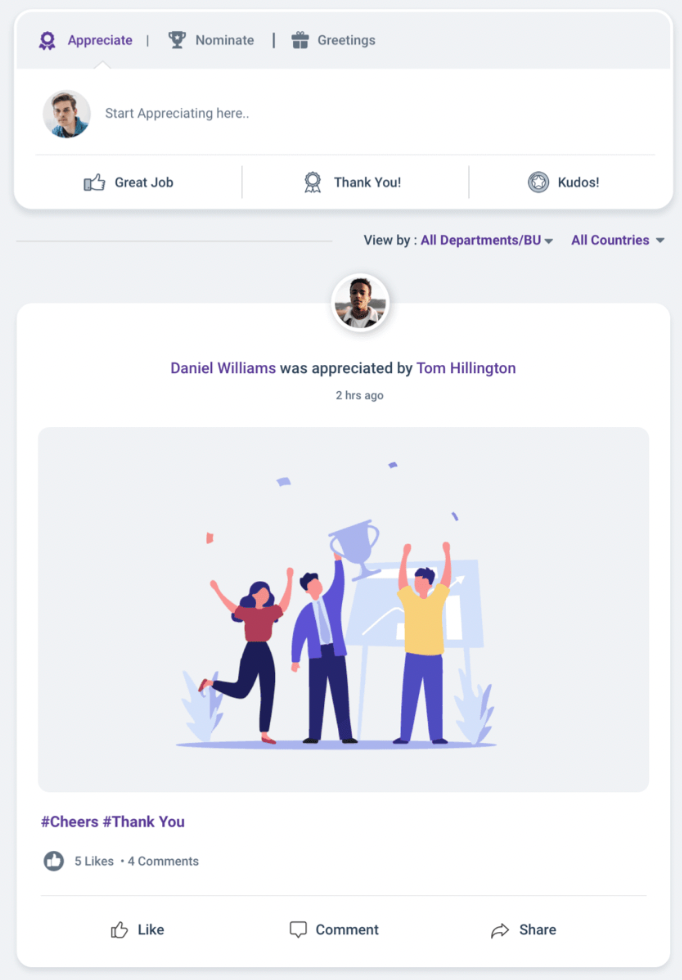
(Source: Vantage Recognition)
Peer recognition hits different because there's no agenda behind it. No performance review implications. Just genuine appreciation from someone who knows the work.
Top-Down Formal Awards
When the CEO personally acknowledges your work, it becomes a story you tell for years. I still remember executives who recognized my contributions a decade ago.
But use these sparingly. Over-recognize from the top, and it loses all meaning.
Spot Awards & Real-Time Recognition
Here's what most managers get wrong: they wait for the "right moment" to recognize good work. By then, the emotional connection is dead.
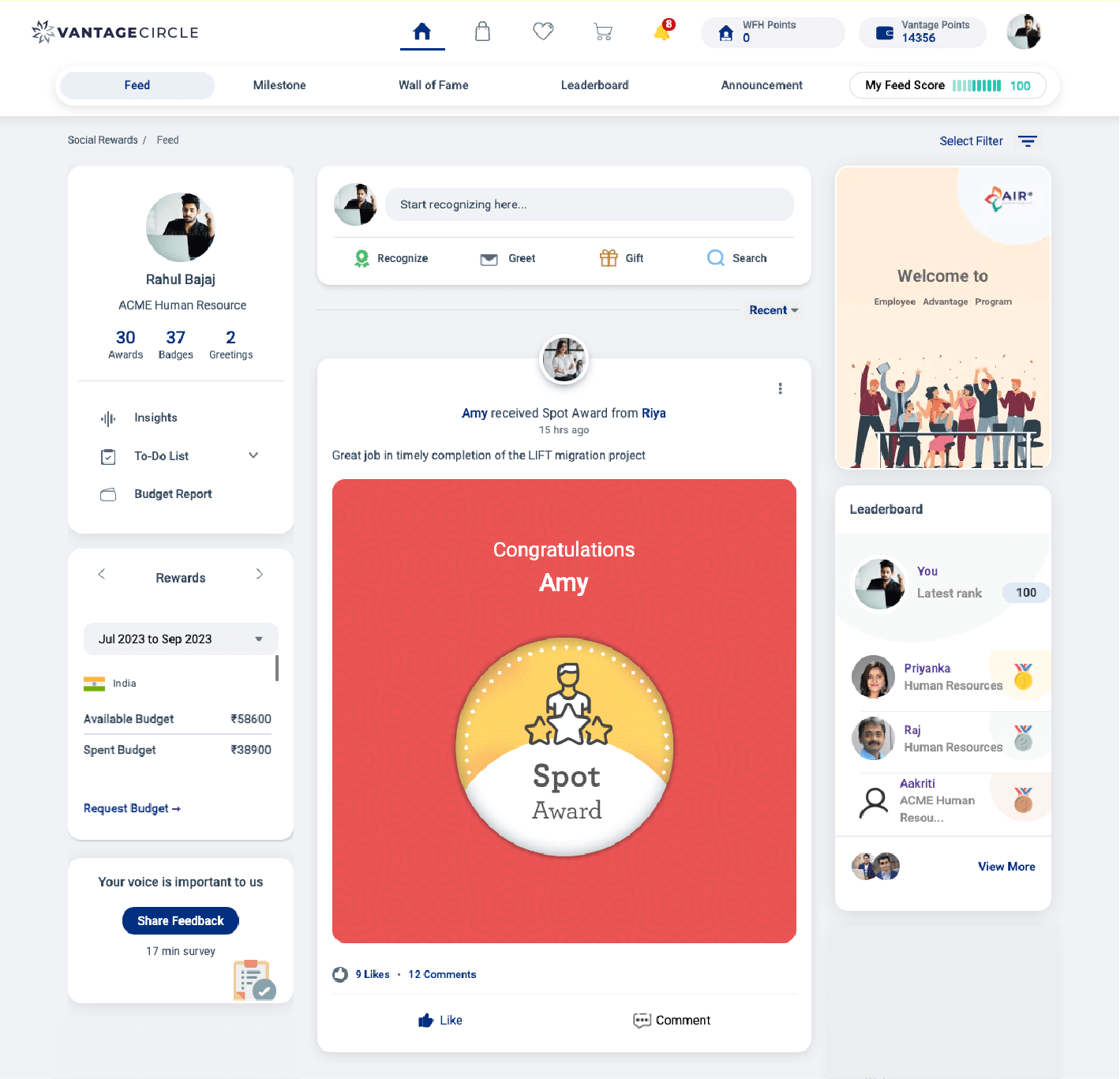
(Source: Vantage Recognition)
I train managers to recognize within 24-48 hours. The brain links action and acknowledgment when they happen close together. Wait a week, and you've lost most of the motivational power.
Read more: What Are Spot Awards and How to Nail a Spot Award Program
Milestone & Anniversary Programs
I used to think anniversary recognition was old-school until I saw a 10-year employee cry when her manager acknowledged her journey.
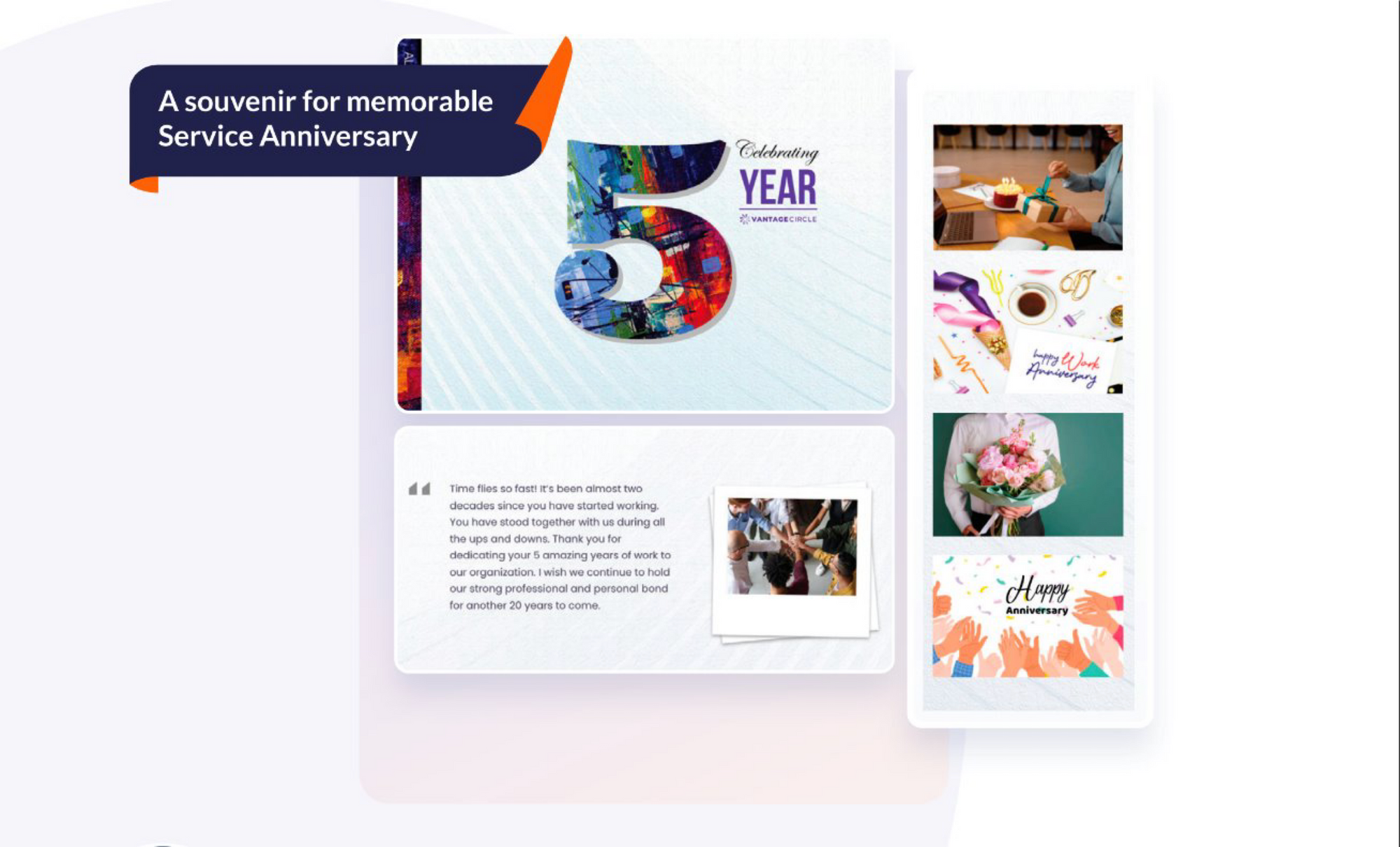
(Source: Vantage Recognition)
People want to feel their loyalty matters. Celebrate work anniversaries, project completions, personal milestones. It shows you value the person, not just this quarter's numbers.
Team-Based Recognition
Nothing kills team chemistry faster than singling out individuals when the win was collective.
I learned this watching a manager recognize one person from a five-person project team. The rest felt invisible. The "winner" felt awkward. Everyone lost.
When teams win together, celebrate them together.
Read More: 7 Impactful Ways to Design a Team-Based Rewards Program
Cross-Departmental Recognition
Want to break down silos overnight? Start celebrating collaboration between departments.
When I publicly recognized both marketing and sales for a seamless campaign launch, something shifted. Other departments started looking for collaboration opportunities because they wanted that recognition too.
Related Article: Power Of Collaboration In The Workplace- Know It All Here
Step 4: Budget Planning and Resource Allocation

Industry Benchmarking (1% Payroll Rule)
Most successful companies spend about 1% of payroll on recognition. That's your starting point, not your ceiling or floor. (SHRM)
I've seen tech companies spend 3% and get amazing results. I've seen manufacturing companies do wonders with 0.5%. Know your industry and culture.
Cost-Benefit Analysis Framework
Best ROI calculation I ever did: A $50,000 recognition program prevented the loss of two key engineers (replacement cost: $300,000 total). That's 500% ROI before you count productivity gains and morale boosts.
Do the math for your situation. The numbers usually shock executives into taking recognition seriously.
Platform vs. Manual Cost Comparison
Small teams under 50 people? I've seen magic happen with handwritten notes and team meetings. Personal touch beats technology every time at that scale.
But try managing recognition for 500+ employees manually? You'll burn out your HR team and miss half your people. Know which camp you're in.
ROI Calculation Methods
I track both hard numbers (turnover reduction, productivity gains) and soft indicators (engagement, satisfaction scores).
Good recognition programs show 200-400% ROI within year one. If yours doesn't, either your approach is wrong or your measurement is missing something important.
Here’s an eye opening stat: Employee turnover costs U.S. businesses $1 trillion annually due to voluntary turnover, making recognition programs a critical retention investment.
Step 5: Technology Platform Selection

Platform Evaluation Criteria
I've watched feature-rich platforms fail because managers found them clunky. The best platform is the one people actually use consistently.
Test with real users, not just decision-makers. If your managers struggle with the demo, imagine how they'll handle it under deadline pressure.
Integration Requirements
Recognition platforms that don't talk to your existing systems become islands that people visit rarely.
Your platform should integrate with HRIS, performance management, and communication tools. Recognition should feel natural within existing workflows, not like extra homework.
Scalability Considerations
I helped a startup pick a platform that worked great for 100 employees but crashed and burned at 500. Switching platforms mid-growth is expensive and demoralizing.
Plan for where you'll be in three years, not just where you are today.
User Experience Priorities
Intuitive beats feature-rich every single time. I'd rather have a simple platform that gets used daily than a complex one that sits gathering digital dust.
Hence, consider the overall user experience in the long run.
Step 6: Launch Strategy and Change Management
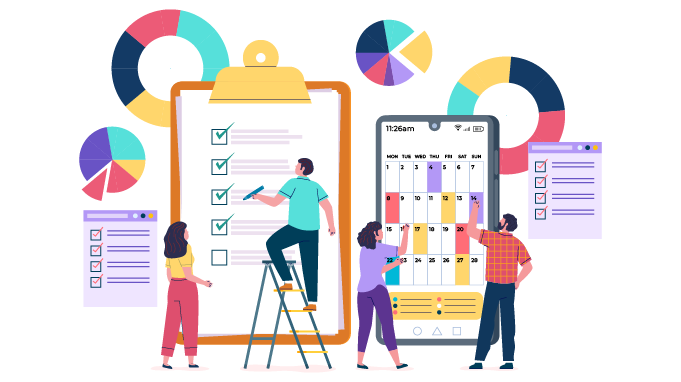
Stakeholder Buy-In Strategies
Here's the truth: if your executives don't visibly use the recognition program, nobody else will either.
I make leadership adoption a mandatory parameter. When people see the CEO recognizing great work consistently, everyone follows suit. Executive behavior is your most powerful change management tool.
Communication Planning
I over-communicate the "why" behind every recognition program I launch. People need to understand the purpose and benefits, not just the mechanics.
Share early wins loudly. Celebrate initial success stories. Show skeptics it's working, and they become converts.
Training and Onboarding
Most managers have never been taught how to give meaningful recognition. It's a skill that requires development.
I provide scripts, examples, and role-playing practice. Build competence and confidence before expecting consistent results.
Pilot Program Design
Always start small. Pick one department, gather feedback, make adjustments, then roll out company-wide.
My pilot programs catch issues before they become company-wide disasters. Plus, your pilot group becomes your best advocates during full launch.
Step 7: Measure, Iterate, and Optimize
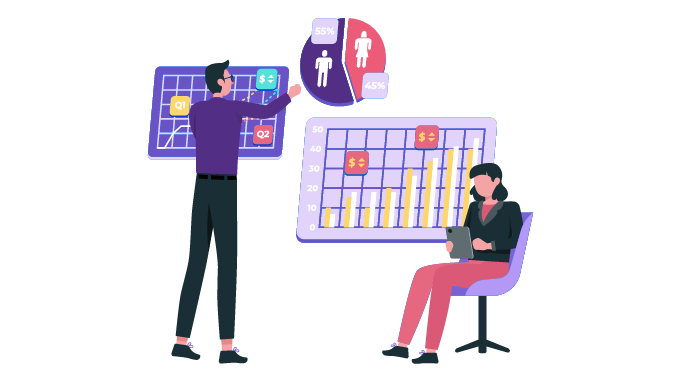
Key Performance Indicators
I track both usage metrics (how often recognition happens) and impact metrics (what changes as a result).
Monitor recognition frequency and participation alongside engagement scores and turnover rates. You need both sides to understand what's really working.
Feedback Collection Methods
Quarterly pulse surveys beat annual feedback every time for recognition programs. People's preferences evolve, and your program should evolve with them.
Ask specific questions about recognition frequency, quality, and personal impact. Generic "how satisfied are you" questions tell you nothing useful.
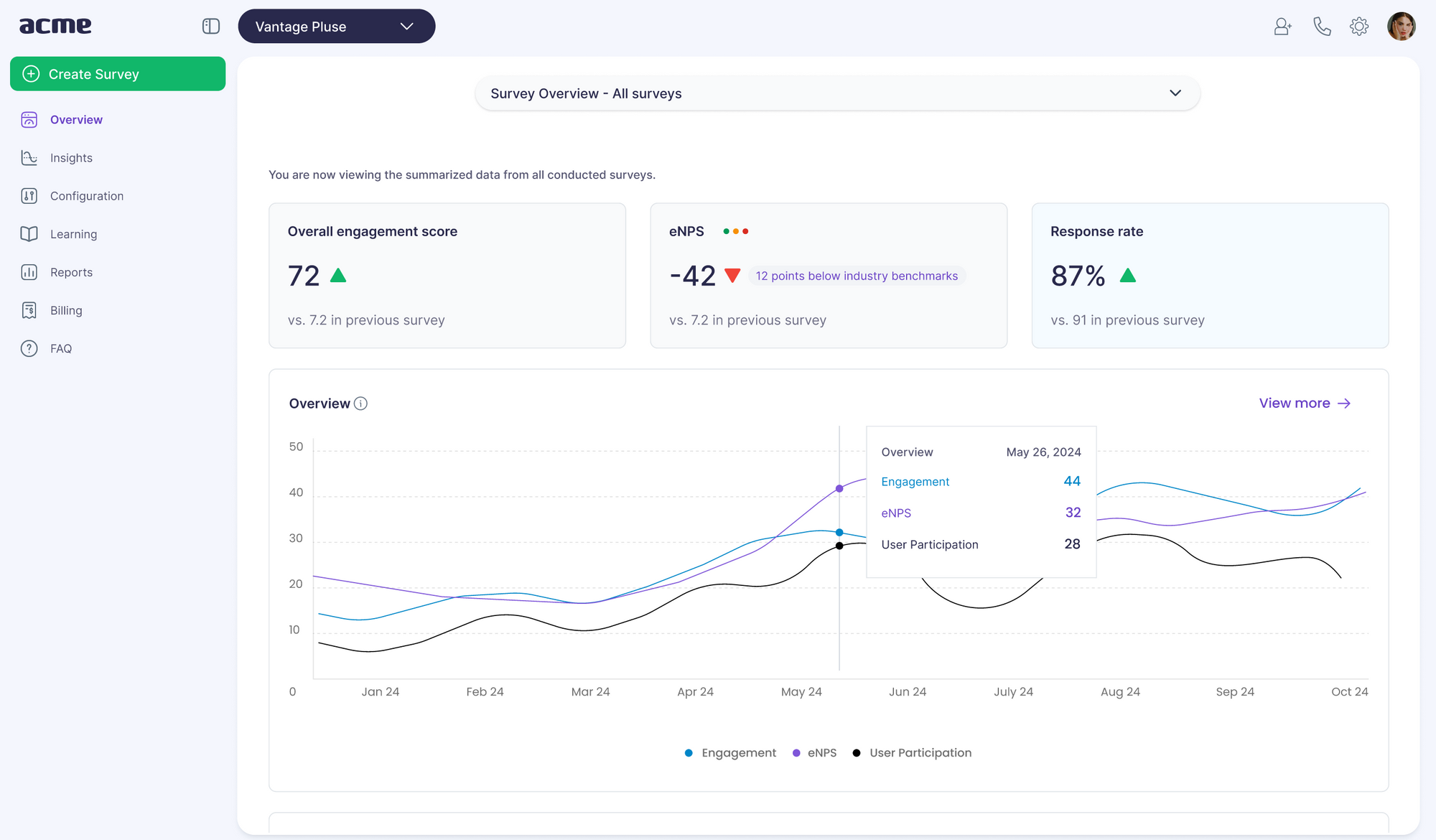
If you want to generate genuine feedback then you can adopt the Vantage Pulse platform. It is easy to use, provides in-built templates, and comes with real-time database. This helps in good decision-making that interests the workforce in the long run.
Continuous Improvement Process
Recognition programs need regular tune-ups. What felt fresh last year might feel stale today.
I review program effectiveness quarterly and make adjustments. Small tweaks prevent major overhauls later.
Program Evolution Strategies
As recognition cultures mature, needs change. Early programs focus on frequency. Mature programs focus on quality and personalization.
Growing companies especially need flexible programs that adapt to new roles, departments, and challenges.
The Reality Check
Here's what my experience has taught me: building a recognition program is easy. Building one that actually changes culture is hard work.
The companies that succeed treat recognition like any strategic initiative—with planning, resources, and ongoing attention. The companies that fail treat it like a nice-to-have HR project.
When done right, recognition becomes your secret weapon for attracting talent, boosting performance, and creating a workplace where people genuinely want to give their best.
Skip steps, and you'll join the graveyard of failed recognition programs. Follow the blueprint, and you'll build something that transforms how people feel about coming to work. The choice is yours. Choose wisely.
How to Recognize the Remote, Hybrid and Multi-Generational Team

2020 broke my recognition programs overnight.
My carefully crafted in-person systems suddenly meant nothing. That "Employee of the Month" plaque? Gathering dust on someone's home shelf where nobody would see it.
But here's what really humbled me: I was recognizing a 25-year-old developer in Berlin the same way I recognized a 58-year-old manager in Chicago. It wasn't working for either of them.
Today's workforce is beautifully complex—Gen Z in coffee shops, millennials managing kids on Zoom, Gen X leading from home offices, Boomers preferring phone calls over Slack. When you crack this code, you unlock loyalty everywhere. When you don't? The engagement scores tell the story.
One in four organizations find their current recognition programs are ineffective for millennial workers, with 38% of millennials wanting to see their employer's recognition program improved. (Source)
Remote Recognition Reality Check

When Great Work Goes Invisible
Remote workers do their best work when nobody's watching.
Kevin, our developer, prevented a major security breach at 2 AM on a Saturday. Took me three weeks to find out because he thought it wasn't "worth mentioning." That's when I realized remote contributions vanish into the digital void.
Now I create structured showcases specifically to surface these invisible wins.
Time Zones Kill Momentum
I once praised our London team lead for five minutes—at 6 AM London time. She wasn't even on the call.
Plan recognition for overlapping hours or record personal video messages. Recognition while half your team sleeps doesn't work.
Cultural Landmines Everywhere
What motivates Tokyo embarrasses Mumbai.
I've watched employees from different cultures react completely differently to identical recognition. Some beam at public praise; others hide under their desks. Offer multiple ways to acknowledge great work.
Tech Comfort Varies Wildly
Boomers struggle with fancy apps while Gen Z gets frustrated with "outdated" emails.
Provide multiple recognition paths. The method matters less than consistency.
Digital Recognition That Actually Works

Virtual Ceremonies That Don't Suck
Screen fatigue is real, but meaningful virtual celebrations still create impact.
Keep them short, interactive, personal. I use breakout rooms and throw in music or backgrounds to make moments memorable. People remember when you try to make it special.
Social Platforms Done Right
Slack and Teams can become recognition hubs where achievements get celebrated real-time.
The key? Making it feel authentic, not like corporate cheerleading. One feels genuine, the other feels forced.
Video Messages Hit Different
A 30-second personal video beats any lengthy email.
Seeing someone's face and hearing genuine appreciation creates connection text can't match.
Mobile or Bust
If recognizing someone takes more than 30 seconds on mobile, people won't do it.
I've tested this—complex recognition flows die within weeks.
Keep it short and simple but authentic.
Keeping It Human

Personal Details Matter
Include specifics that show you really see the person. "Thanks for the presentation" versus "Your client presentation secured our biggest deal—the way you handled their implementation concerns showed real expertise."
The story makes it memorable and adds value to the appreciation.
Private > Public Sometimes
I schedule one-on-one calls specifically for recognition. These personal moments often matter more than public acknowledgments.
It's where real connection happens.
Hybrid Workplace Equity

The Office Advantage Problem
Office presence shouldn't equal more recognition, but I've seen it happen repeatedly.
I track recognition patterns obsessively to ensure remote workers get equal acknowledgment.
Everyone Participates or Nobody Does
Live-stream office celebrations. Create interactive elements for remote attendees. Nobody should feel second-class.
Recognize When It Happens
Some of my best performers do their magic at midnight. Don't wait for team meetings to acknowledge great work.
Be present at the moment. If not then do not delay it.
Generational Truths I've Learned
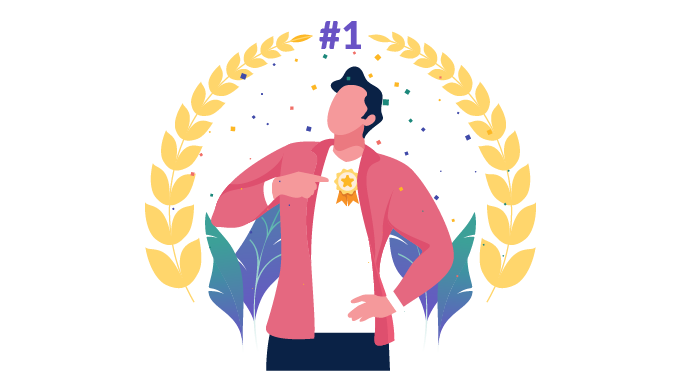
Gen Z Wants It Fast and Public
They thrive on social recognition and transparent career progression. Tie recognition to growth opportunities. That's what keeps them engaged.
Millennials Need Purpose
Highlight how their work creates positive change. They want to know their effort matters beyond the bottom line.
Gen X Wants Respect for Results
Gen X wants straightforward, results-focused recognition. Keep it professional and meaningful. They don't need elaborate celebrations.
Boomers Prefer Face-to-Face
Acknowledge their mentorship and institutional knowledge. A phone call often resonates more than digital-only approaches. They've earned respect—show it.
How to Choose the Right Digital Recognition Platform

I've watched companies spend six figures on recognition platforms that nobody uses.
The shiny demo looked amazing. The features list was impressive. The vendor promised to "transform workplace culture overnight." Six months later, managers were back to sending thank-you emails because the platform was too clunky to bother with.
Choosing a recognition platform is like picking a CRM—get it wrong, and you're stuck with expensive software gathering digital dust. Get it right, and you've got a system that actually drives the behaviors you want to see.
Here's what most vendors won't tell you: the platform doesn't create culture—it amplifies what you're already building.
Your job isn't finding the platform with the most bells and whistles. It's finding the one that fits how your people actually work.
Platform Selection Reality Check

Core Functionality That Actually Matters
Your platform should handle peer-to-peer recognition, manager nominations, and milestone tracking without making people want to scream.
I've tested platforms where giving simple recognition required seven clicks and two approval workflows. If the core features feel clunky during the demo, they'll be torture in daily use.
Look for customizable recognition types and reward catalogs that match your company's personality, not some vendor's idea of corporate culture.
Integration or Death
A recognition platform that doesn't play well with your existing tools becomes an expensive island nobody visits.
I've seen beautiful platforms fail because they required people to leave Slack, log into another system, remember their password, and navigate unfamiliar menus just to say "thank you." That's not recognition—that's punishment.
The best recognition happens within existing workflows, not as homework.
User Experience Is Everything
If managers find your platform confusing, they won't use it. Period.
I always test platforms with actual users, not just IT decision-makers. The interface should be intuitive enough that someone can give recognition in under 60 seconds without calling the help desk.
Analytics That Actually Help
Good platforms show recognition patterns, participation rates, and program ROI with insights you can act on.
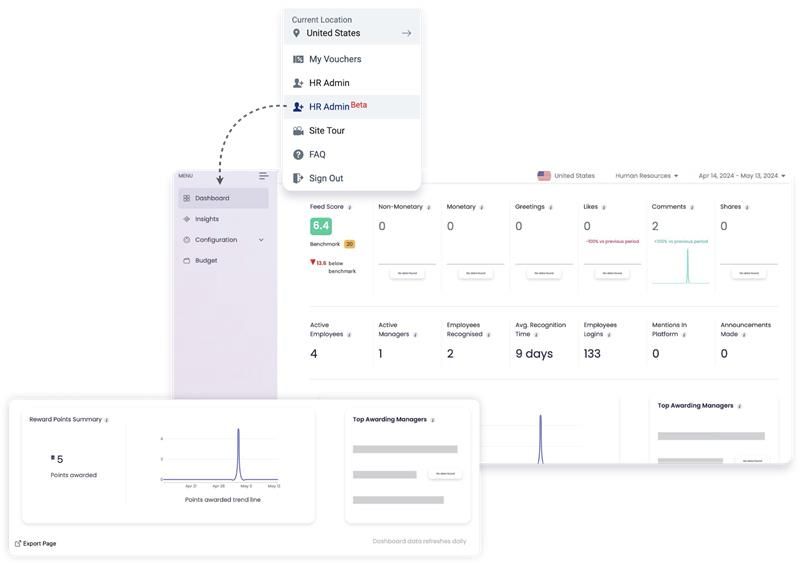
(Source: Vantage Recognition)
I need dashboards that help managers spot under-recognized team members and track cultural health. Data without actionable insights is just expensive noise that makes pretty reports nobody reads.
Security Isn't Optional
Your recognition data is employee data— treat it like payroll information.
Ensure the platform meets compliance requirements (GDPR, SOC 2, etc.) and offers proper encryption. Ask specific questions about data residency and access controls. If the vendor gets vague about security, keep looking.
Industry Fit Matters

One Size Doesn't Fit All
The best platforms adapt to your industry's language and culture without requiring custom development.
A hospital needs different recognition categories than a tech startup. Manufacturing teams care about safety behaviors; creative agencies celebrate innovation. Smart platforms offer industry templates that actually make sense for your world.
I've seen generic platforms try to force healthcare teams into "sales achievement" categories. It's embarrassing for everyone involved.
Custom vs. Off-the-Shelf Truth

Off-the-Shelf Usually Wins
Faster implementation, proven functionality, ongoing updates without bleeding money on developers.
Most companies can hit 80% of their recognition goals with configurable solutions. That remaining 20%? Usually not worth the pain and expense of custom development.
Custom Makes Sense Sometimes
Large enterprises with truly unique requirements or strict compliance needs might need custom solutions.
But before going down that road, honestly assess whether your "unique" requirements are actually unique or just preferences. I've seen companies spend millions customizing platforms for features they never actually used.
Implementation Without Disaster

Clean Your Data First
Garbage in, garbage out applies to recognition platforms.
Map your current recognition categories and employee data to the new structure. Plan validation periods and have rollback procedures ready. Nothing kills adoption faster than incorrect employee information or broken reward redemptions.
People Need Hand-Holding
Platform adoption depends more on change management than features.
Create role-specific onboarding for managers, employees, and administrators. Include real examples that match your company's culture, not generic corporate scenarios that make people's eyes glaze over.
Build Internal Champions
Invest in train-the-trainer programs so you're not calling vendor support every time someone can't figure out how to redeem points.
Develop internal champions who can troubleshoot common issues and evangelize success stories. Vendor support should handle technical problems, not basic usage questions.
Monitor Everything
Track technical performance and user adoption from day one.
I monitor system uptime, page load speeds, and error rates alongside participation rates and recognition frequency. Technical problems kill adoption faster than missing features.
Integration Is Make-or-Break

HRIS Integration
Seamless employee data sync eliminates manual administration and reduces recognition delays.
Look for real-time sync that handles organizational changes, new hires, and role updates automatically. Manual data management becomes impossible as you scale.
Slack and Teams Integration
Recognition should happen where people already communicate, not in a separate system they need to remember to visit.
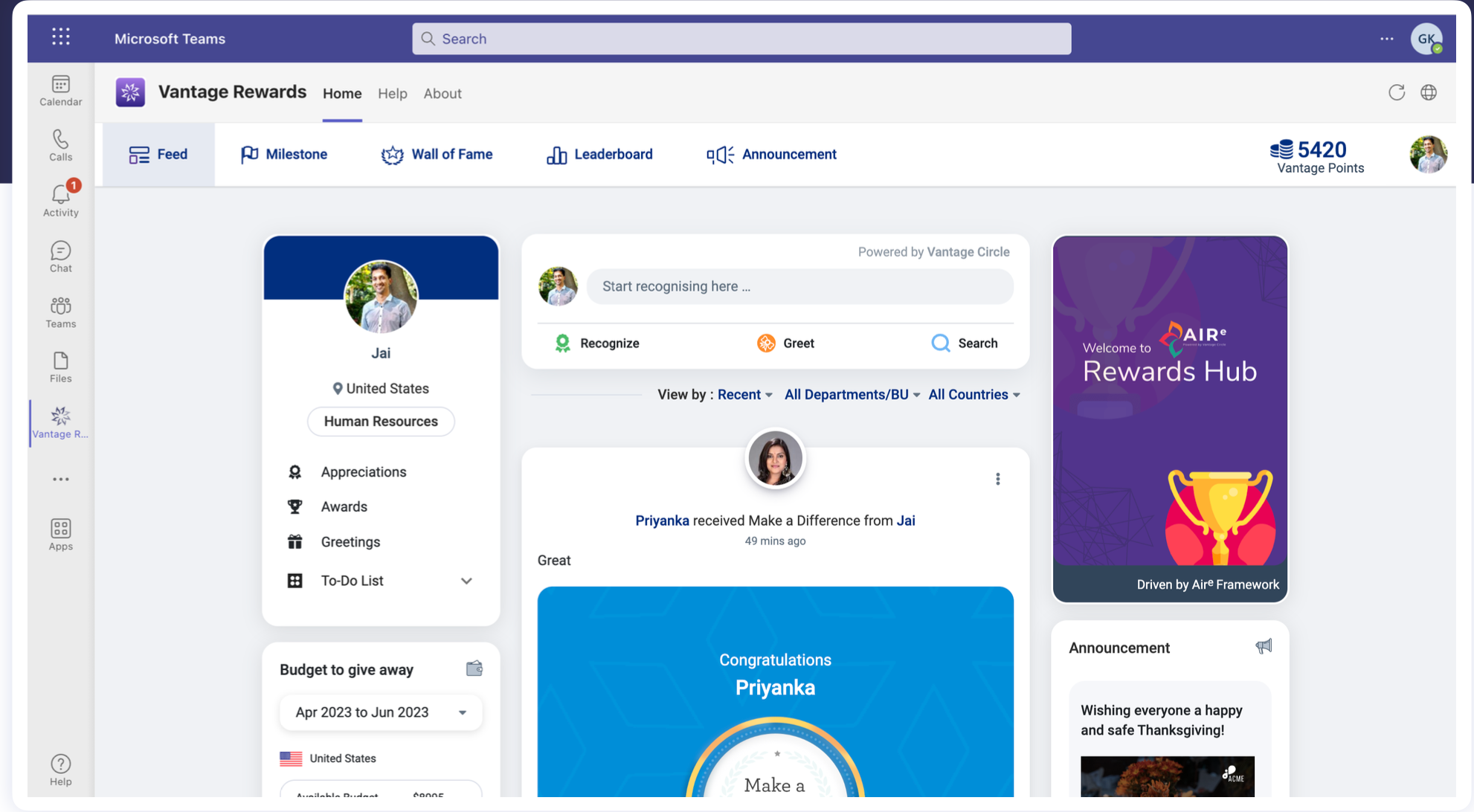
(Source: Vantage Recognition)
The best integrations allow full recognition workflows within Slack or Teams. If people have to leave their communication platform to give recognition, adoption tanks.
Performance Management Connection
Connect recognition data to performance reviews for a complete picture of contributions.
Integration should flow both ways—recognition tied to goals appears in performance discussions, and achievements trigger recognition opportunities.
Learning System Links
When someone completes certification or demonstrates new skills, make it easy to acknowledge both the learning and its application.
This creates a continuous growth culture where development gets celebrated, not just results.
What are the Examples of Employee Recognition
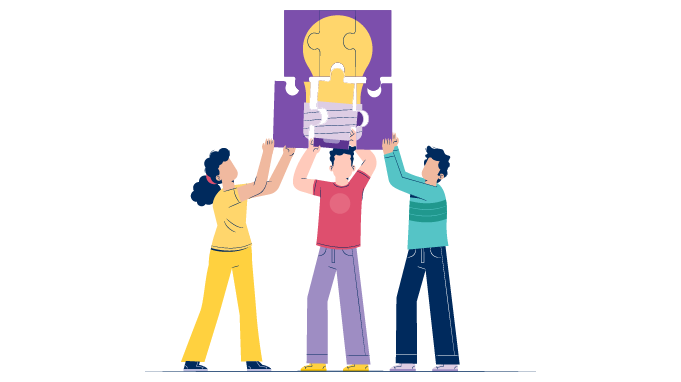
Recognition programs work differently across industries, company sizes, and cultures. But the best programs share common DNA: they're intentional, consistent, and tied directly to business outcomes.
Case Study 1: Hilton's Recognition Calendar Strategy
The Challenge
-
Hilton needed to create consistent recognition across 7,000+ properties worldwide with diverse cultures and management styles.
-
With high turnover rates plaguing the hospitality industry and guest satisfaction directly tied to employee engagement, Hilton faced the challenge of making every team member feel valued regardless of location or role.
The Solution
-
Hilton built a comprehensive year-round recognition calendar anchored in their HILTON values (Hospitality, Integrity, Leadership, Teamwork, Ownership, Now).
-
They created multiple overlapping programs: the CEO Light and Warm Award ($10,000 bonus for exceptional leaders), Catch Me at My Best peer recognition, Team Member Appreciation Week, and Department of the Month celebrations.
Implementation Process
-
Hilton established five non-negotiable keys to recognition: make it frequent, timely, specific, personal, and tied to big-picture impact.
-
They trained managers globally on these principles and created simple "Value Certificates" that any employee, guest, or manager could fill out when witnessing behaviors that reflected company values.
-
The recognition calendar ensured something was always happening—no dead periods where appreciation disappeared.
Results and ROI
-
Within three years, Hilton achieved a 6% reduction in overall turnover and 13% decrease in millennial turnover specifically.
-
Guest loyalty increased by 9%, with research showing that a 5% customer loyalty increase correlated to 1.1% revenue growth the following year.
-
Employee engagement reached 80% in 2019, with 93% of employees reporting positive work experiences.
-
The company attributed profits of more than 20% year-over-year and doubled earnings per share directly to positive team member experiences.
Key Learnings
-
Recognition consistency matters more than recognition frequency—Hilton's calendar approach ensured no one fell through the cracks.
-
Peer recognition (Catch Me at My Best) often carried more authenticity than top-down awards because it came from daily work interactions, not performance reviews.
-
Tying recognition directly to company values (HILTON acronym) reinforced desired behaviors while giving recognition structure.
-
The most effective programs offered both individual recognition (CEO awards) and group celebrations (Team Appreciation Week) to meet different personality preferences.
-
Simple tools work best—Hilton's Value Certificates required no technology, just intentional observation and appreciation.
-
Training managers on recognition principles created consistency across properties without requiring expensive platform implementations.
Read the full Hilton case study here.
Case Study 2: Cisco's Peer-to-Peer Revolution
The Challenge
-
Cisco's traditional spot bonus program was invisible and manager-dominated, creating inconsistent recognition across 70,000+ employees in 90 countries.
-
Only managers could give rewards, and recognition happened in silos—teammates never knew when someone was acknowledged for great work. This lack of visibility meant exceptional contributions often went unnoticed by the broader organization.
The Solution
-
Cisco launched "Connected Recognition," a peer-to-peer program funded at 1% of payroll and built around their core values: Connect Everything, Innovate Everywhere, Benefit Everyone.
-
They partnered with recognition platform providers to create a tech-powered platform that empowered every employee to recognize colleagues with awards ranging from $25 to $500, plus non-monetary thank-you options.
Implementation Process
-
Cisco made recognition part of their broader "People Deal" culture transformation, positioning it as central to the employee experience.
-
They trained leaders on the business case for recognition and created simple workflows that allowed anyone to nominate colleagues within their existing work tools.
-
The program launched with clear guidelines: recognition should be frequent, specific, and tied to cultural values.
-
Awards required minimal approval for smaller amounts ($25 level), making recognition immediate rather than bureaucratic. Larger Connected Achievement awards ($500+) needed manager approval but maintained focus on peer nomination.
Results and ROI
-
In year one, 85% of Cisco's 70,000 employees gave or received recognition—remarkable participation for an optional program.
-
After five years, the program has distributed over 1.2 million awards, with 600+ recognitions happening daily across the organization.
-
48% of awards now come from individual contributors recognizing peers, demonstrating the cultural shift from top-down to peer-driven appreciation.
-
93% of leaders actively participate in recognition, and 90% of all employees have received acknowledgment through the platform.
-
Business impact includes higher engagement scores, stronger retention rates, and improved team connectivity.
-
Employees report using rewards for everything from family vacations to charitable giving, with $32,000 donated to global charities in 2018 alone.
Key Learnings
-
Peer recognition carries more authenticity than manager recognition because colleagues see daily work contributions that supervisors might miss.
-
Making recognition visible company-wide creates a positive feedback loop—"greatness inspires more greatness," as Cisco leadership noted.
-
Investment matters—funding at 1% of payroll signals that recognition is a strategic priority, not an afterthought.
-
Data collection is crucial for proving ROI and continuous improvement. Cisco tracks participation patterns to identify underrecognized employees and departments, enabling targeted interventions to ensure equity.
-
Technology should enhance human connection, not replace it. The platform includes video messages and mobile capabilities, but the focus remains on authentic appreciation between colleagues.
Learn more about Cisco's Connected Recognition program.
The Best High-Impact Employee Recognition Ideas That Actually Work

Let's be honest—most employee recognition programs are terrible.
They're either generic "employee of the month" plaques that nobody cares about, or expensive perks that miss the mark completely. But here's what I've learned after working with hundreds of companies: great recognition isn't about your budget. It's about being intentional and authentic.
The companies that get this right? They see 51% lower turnover and 14% better productivity, according to Gallup. But more importantly, their people actually want to come to work.
Here's how to build recognition that your team will actually remember and appreciate.
Low-Cost Winners That Hit Hard (Under $50)

Some of the most meaningful recognition costs almost nothing. I've seen CEOs bring grown employees to tears with a $2 thank-you card.
1. Personal Touch Recognition
• Handwritten notes from leadership are pure gold. When your CEO takes time to write "Your presentation saved the Henderson deal," that note goes on the fridge at home. When employees recall their most memorable recognition, the source is most often their manager (28%), followed closely by a high-level leader or CEO (24%). (Gallup)
• "Caught in the act" certificates work because they're specific and immediate. "Caught being brilliant during the client meltdown" tells everyone exactly what behavior you want to see more of.
2. Team-Focused Ideas
• Team lunch celebrations aren't just about food—they're about shared victory. When everyone knows they're celebrating because they crushed Q3 targets, it reinforces that success is collective.
• Reserved parking spots for top teams are visible daily reminders that excellence gets noticed. Plus, who doesn't love avoiding the parking hunt on Monday morning?
3. Digital Amplification
• LinkedIn company spotlights do double duty—your employee feels proud, and potential hires see what you value. Public recognition boosts employee advocacy by 3x.
• Rotating email signatures turn every company email into a mini celebration. Thousands of people see "Celebrating Tom's supply chain innovation that cut costs 12%."
4. Flexibility That Matters
• Extra PTO days speak to what people really want—time. While others are throwing money around, you're giving something actually precious. 17% of job quitters left because of changes to their working arrangements and reducing flexibility. (Source)
• Executive coffee chats give high performers something they can't get anywhere else—direct access to leadership and career guidance.
Smart Mid-Range Moves ($50-$500)

This is where you start making deeper investments in people's growth and wellbeing.
1. Growth-Focused Recognition
• Conference attendance shows you're betting on their future, not just rewarding their past. People receiving development opportunities stick around longer.
• Certification reimbursements are brilliant because everyone wins—they get new skills, you get better performance. The ROI averages 5:1.
2. Life Enhancement Recognition
• Wellness subscriptions support the whole human, not just the worker. Companies see 28% fewer sick days when they invest in employee health.
• Meal delivery during crunch time says "we know you're working hard, let us handle dinner." It's practical care when people need it most.
3. Work Quality Recognition
• Equipment upgrades improve someone's daily experience for months or years. That ergonomic chair or second monitor pays dividends every single day.
• Thoughtful tech gadgets show you pay attention to individual needs—noise-canceling headphones for the open office warrior, tablets for the frequent traveler.
4. Family-Inclusive Recognition
• Family dinner vouchers acknowledge the support system behind great work. Recognition that includes families builds deeper loyalty.
• Local experience passes create memories beyond work—something they'll remember long after they've forgotten their last performance review.
High-Impact Premium Recognition ($500+)

Save these for your stars and major milestones. They should feel significant.
1. Career Investment Recognition
• Leadership development programs signal serious long-term investment. Organizations looking to attract millennial talent must prioritize career development—it's a dealbreaker for 9 in 10 candidates from this generation.
• Tuition reimbursement shows radical faith in someone's potential—even if it eventually means they outgrow their current role.
2. Experience Creation Recognition
• Vacation packages give people permission to truly unplug. In our always-on culture, sanctioned disconnection is a gift.
• VIP event experiences create stories they'll tell for years—the time their company got them backstage passes or box seats.
3. Ownership Recognition
• Stock options make people think like owners because they literally are. Gartner research reveals that aligning employee objectives with both company priorities and individual aspirations can boost performance by as much as 22%.
• Sabbatical programs after years of service show you understand that great careers need significant breaks to sustain excellence.
4. Values-Driven Recognition
• Charity donations in their name amplify what they already care about. Values alignment drives higher engagement improving the bottomline of the organization.
• Innovation grants for their ideas show ultimate trust—you're literally funding their creativity.
Industry-Specific Hits
Healthcare: Share patient impact stories publicly + fund continued education
Technology: Protect innovation time + celebrate open source contributions
Manufacturing: Celebrate safety milestones + reward process improvements
Retail: Spotlight customer praise + celebrate sales wins as team victories
Financial Services: Recognize relationship building + celebrate compliance excellence
What Actually Makes Recognition Stick
Here's what separates companies that get recognition right from those that waste money on it:
They layer frequent small wins with big milestone moments. Weekly thank-yous plus quarterly celebrations. Both matter, for different reasons.
They know their people individually. Gary loves public shoutouts, Mike prefers private praise. Great managers learn the difference and act accordingly.
They get specific about impact. Instead of "great work," try "your solution saved us three weeks and impressed the client enough to expand their contract."
Recognition isn't a box you check, it's a culture you build one genuine moment at a time. Start with what feels authentic to your leadership style, then scale what actually resonates with your team.
The goal isn't perfect recognition. It's recognition that makes people feel truly seen and valued for their unique contributions.
How to Measure the Success of Employee Recognition

The truth is most companies launch recognition programs. However, then have no idea if they're actually working.
Companies spend serious money on platforms and rewards. But why do they fail? It’s because they can't tell you if recognition is driving retention, engagement, or performance.
What works? Measuring the recognition program you implemented. It is not rocket science. Although it does require the same discipline you'd apply to any other investment.
If you can't measure it, you can't improve it.
Key Performance Indicators That Actually Matter

Participation Metrics
Start here because participation reveals everything about program health. Track who's giving recognition, who's receiving it, and where the gaps are hiding.
• Weekly active users across all employee segments.
• Recognition frequency per manager to identify who needs coaching and who's setting the standard
• Peer-to-peer participation rates because horizontal recognition often matters more than top-down praise
Engagement Metrics
This is where you connect recognition to how people actually feel about work.
• Employee engagement scores with specific questions about feeling valued and appreciated
• Pulse survey results that track sentiment changes over time, not just point-in-time snapshots
• Sentiment analysis of recognition messages to understand quality, not just quantity
Business Impact Metrics
Here's where you prove recognition affects the bottom line, not just warm feelings.
Did you know? Only 30% of employees are actively engaged in the workplace, leaving 70% either not engaged or dysfunctional.
• Retention rates broken down by recognition level—people who feel appreciated stick around
• 90-day new hire retention because early recognition sets the tone for entire tenures
• Performance ratings comparing recognized vs. unrecognized employees over time
ROI That Makes Sense
Calculate program costs against tangible business outcomes, but be realistic about attribution.
Factor in platform costs, reward budgets, and administrative time versus avoided turnover expenses and measurable productivity increases. Most solid programs show 200-400% ROI within the first year, but don't cook the books to hit those numbers.
Smart Data Collection Strategies

Automated Platform Analytics
Modern recognition platforms capture incredible data without extra work from anyone. Use it.
• Usage patterns showing when and how people give recognition
• Award distribution revealing whether recognition is fair or concentrated
• Behavioral trends that predict engagement before it becomes a retention problem
The best part? No manual data entry required. The system tracks everything automatically while people use it naturally.
Employee Survey Methods
Quarterly pulse surveys with targeted recognition questions give you insights no platform can capture.
Ask specific questions like-
-
"How often do you feel recognized for your contributions?"
-
"Does the recognition you receive align with your actual impact?"
Keep surveys short but strategic—five targeted questions beat twenty generic ones every time.
Manager Feedback Systems
Create structured monthly check-ins where managers share recognition wins, identify team members who seem disengaged, and suggest program improvements based on what they're seeing daily.
These conversations often reveal program blind spots that data alone misses.
Business Performance Correlation
Connect recognition timing to actual business results—this is where measurement gets really powerful.
Look for patterns between recognition frequency and performance spikes, project completion rates, customer satisfaction improvements, and quality metrics. The correlations are often stronger than you'd expect.
Reporting That Drives Action

Executive-Level Dashboards
C-suite leaders don't need operational details—they need strategic insight.
Focus on business impact, ROI trends, and culture metrics that connect to company goals. Show retention improvements, engagement score changes, and program ROI alongside basic participation data.
Keep it simple: three key metrics that executives can understand in thirty seconds.
Manager Dashboard Requirements
Managers need actionable intelligence about their teams, not corporate-level summaries.
• Team participation rates so they know if their people are engaging
• Under-recognized employee alerts to catch potential retention risks early
• Recognition suggestions based on performance data and peer feedback patterns
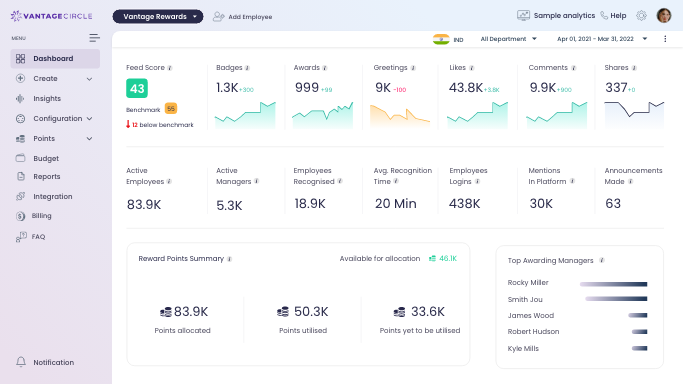
(Source: Vantage Recognition)
Make it easy for managers to act on the data, not just consume it.
Employee Transparency
When people see fair recognition distribution, they trust the system more and participate more actively.
Show company-wide recognition trends, team achievements, and individual contribution acknowledgment without creating unhealthy competition. Transparency builds credibility faster than any communication campaign.
Real-Time vs. Periodic Reporting
Balance immediate alerts with trend analysis. Use real-time data for urgent issues like recognition gaps or participation drops, but rely on monthly and quarterly reports for strategic program adjustments.
Building Continuous Improvement

A/B Testing That Teaches
Test different recognition approaches with similar employee groups to learn what actually drives engagement and retention.
Experiment with recognition frequency, reward types, and delivery methods while keeping measurement criteria consistent. Small changes can reveal big insights about what motivates your specific culture.
Feedback Loops That Work
Create systematic processes for collecting, analyzing, and acting on feedback from everyone involved.
Establish monthly review cycles where feedback drives specific program changes, then communicate those improvements back to employees who provided input. People need to see their suggestions matter.
Smart Program Evolution
Plan quarterly program reviews with annual major updates based on solid data trends and employee feedback.
Make small tweaks frequently, but save major program changes for thorough analysis and pilot testing. Don't fix what's already working well just because something new sounds interesting.
Industry Benchmarking
Compare your metrics against industry standards and best-practice companies, but adapt insights to your unique culture.
Use external benchmarks for participation rates, ROI expectations, and engagement correlation while remembering that your company isn't exactly like anyone else's.
Your 90-Day Employee Recognition Implementation Roadmap

Look, we get it. Launching a recognition program can feel like you're juggling while riding a unicycle.
You want to do right by your people, but you're also worried about messing up something that should make everyone happy. With 42% of employee turnover being preventable but often ignored, a structured recognition implementation can significantly impact retention.
Here's what usually happens: companies either panic-launch something half-baked, or they get stuck in planning purgatory while their best employees start updating their LinkedIn profiles.
This roadmap is your middle path—thoughtful enough to work, fast enough to matter.
Days 1-30: Getting Everyone on Board
Week 1: Win Over Your Leaders
-
Executive Buy-in Sessions: Show your leaders why this matters—share stories about people leaving because they felt invisible.
-
Budget Talks: Secure your funding by framing it as keeping great people, not just another expense.
-
Assemble Your Team: Find your passionate allies in HR, IT, and departments who genuinely care about culture.
Week 2: Face the Truth
-
Current State Check: Use the AIRe assessment to see where you really stand—no sugar-coating allowed.
-
Ask Your People: Launch a simple survey asking what makes them feel appreciated. Their answers might surprise you.
-
Find the Gaps: Identify where people feel overlooked or undervalued—these are your starting points.
Week 3: Design Something Real
-
Set Your Standards: Define what behaviors you actually want to celebrate—make it specific and meaningful.
-
Choose Your Mix: Blend peer appreciation, formal recognition, and milestone celebrations that feel authentic to your culture.
-
Shop for Tools: Shortlist platforms that fit how your team actually works, not how consultants think they should.
Week 4: Pick Your Partner
-
Test Drive Options: Bring real users into demos—they'll spot problems executives miss every time.
-
Make the Deal: Negotiate contracts without nasty surprises hiding in the fine print.
-
Start Building: Configure the basics and make it feel like your company, not another generic tool.
Days 31-60: Build Something People Will Use
Week 5-6: Make It Flow
-
Connect Everything: Link your recognition platform to existing tools so it feels natural, not like extra work.
-
Set Permissions: Give people the right access without creating approval nightmares that kill spontaneous appreciation.
-
Design Simple Workflows: Create easy ways to say "thank you" without jumping through corporate hoops.
Week 7-8: Get People Excited
-
Create Helpful Training: Skip the corporate speak and focus on real examples that actually help managers.
-
Build Buzz: Generate genuine excitement, not just another announcement people will ignore.
-
Choose Your Pilots: Pick early adopters who'll become your biggest cheerleaders if you get this right.
Days 61-90: Launch and Learn Fast
Week 9-10: Start Small, Start Strong
-
Train Your Pilots: Make sessions encouraging and hands-on—people need confidence, not confusion.
-
Celebrate Early Wins: Shout about every success to build momentum across the organization.
-
Listen Carefully: Your pilot group's feedback is gold—they're living with your decisions every day.
Week 11-12: Open the Floodgates
-
Go Company-Wide: Launch with energy and clear communication about why this matters to everyone.
-
Be Present: Some people need hand-holding, others just want quick answers—meet them where they are.
-
Stay Close: Early frustrations can kill adoption faster than any technical problem.
After Launch: Keep It Growing
30-Day Reality Check
-
Spot the patterns and celebrate people who are making it work.
-
Help the stragglers catch up—some teams just need extra encouragement to participate.
60-Day Deep Dive
-
Analyze what's actually happening and adjust based on real usage, not assumptions.
-
Check with your people to make sure it feels authentic and valuable, not forced.
90-Day Victory Lap
-
Measure real business impact on retention and engagement—this justifies everything.
-
Plan what's next based on what you've learned about your unique culture.
Here's the thing: You are creating a space where employees know their work holds value and it matters.
Take things slow, listen to your people, and make them feel appreciated when necessary.
FAQs
Program Design and Strategy
Q1. What is the best type of employee recognition for 2025?
A. A blend of frequent peer-to-peer appreciation through digital tools and meaningful quarterly milestone celebrations that feel personal and specific.
Q2. How much should a company budget for employee recognition?
A. Around 1% of payroll is the industry standard, with effective programs typically showing 200-400% ROI through reduced turnover.
Q3. What's the difference between recognition and rewards?
A. Recognition is verbal acknowledgment of contribution, while rewards are tangible benefits like bonuses or gifts.
Q4. How do you measure the ROI of recognition programs?
A. Track turnover reduction, productivity gains, and engagement scores against program costs to calculate clear financial impact.
Q5. What are the most common recognition program mistakes?
A. Being too generic, recognizing only top performers, making the process complicated, and launching without manager training.
Remote and Hybrid Workplace
Q1. How do you recognize employees in a remote workplace?
A. Use digital tools for frequent shoutouts, send personal video messages, and create virtual celebrations that work across time zones.
Q2. What are the best digital recognition platforms?
A. Vantage Circle is one of the popular choices, but pick whatever integrates seamlessly with your existing tools.
Q3. How do you ensure equity between remote and in-office employees?
A. Track recognition data by location to spot bias and create deliberate opportunities to showcase remote contributions.
Q4.What technology is essential for remote recognition?
A. A mobile-friendly platform that integrates with Slack/Teams and allows instant recognition without approval delays.
Implementation and Management
Q1. How often should employees be recognized?
A. Weekly for small wins and quarterly for major milestones—most employees need acknowledgment at least monthly to feel valued.
Q2. Who should be responsible for giving recognition?
A. Everyone participates, but managers own creating a culture where recognition flows naturally in all directions.
Q3. How do you handle recognition in union environments?
A. Work with union leadership to ensure programs complement agreements and focus on equitable recognition that doesn't create tension.
Q4. What are the legal considerations for recognition programs?
A. Ensure fair treatment for all, document clear criteria to avoid discrimination claims, and understand tax implications for valuable rewards.
Q5. How do you maintain program momentum over time?
A. Refresh regularly based on feedback, celebrate recognition champions, track impact metrics, and keep leadership visibly participating.
Cultural and Diversity Considerations
Q1. How do you ensure recognition is culturally sensitive?
A. Ask employees their preferences and offer multiple recognition methods so people choose what feels comfortable for their background.
Q2. What about generational differences in recognition preferences?
A. Offer diverse options—digital and face-to-face, public and private—because individual personality matters more than age stereotypes.
Q3. How do you avoid bias in recognition programs?
A. Track data by department and demographics, train managers on unconscious bias, and create specific criteria for fair acknowledgment.
Q4. What role does inclusion play in recognition?
A. It ensures everyone feels valued regardless of working style and celebrates diverse contributions including behind-the-scenes work.
Industry-Specific Questions
Q1. How does recognition work in manufacturing environments?
A. Focus on safety achievements and team wins with real-time acknowledgment on the floor, not in emails.
Q2. What are special considerations for healthcare recognition?
A. Acknowledge emotional labor beyond metrics, rotate recognition times for all shifts, and enable peer support systems.
Q3. How do retail companies implement recognition programs?
A. Use mobile-first platforms, celebrate customer feedback publicly, and make recognition as immediate as the fast-paced environment.















